#949 Haggis and Scotch pies
The Larder of the Wise: The Story of Vancouver’s James Inglis Reid Limited
by M. Anne Wyness, with a foreword by Michael Kluckner
Vancouver: Figure 1 Publishing, 2019
$32.99 / 9781773271187
Reviewed by Mary Leah de Zwart
*
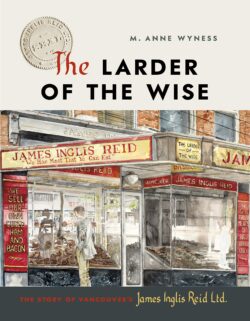 In The Larder of the Wise: The Story of James Inglis Reid Limited, M. Anne Wyness promises a unique story of an independent grocery business opened in Vancouver in 1908 by James Reid, a Scottish immigrant. “We ha’e meat that ye can eat” — an adapted version of the Selkirk Grace — was the slogan of Reid’s high-quality grocery, specializing in cured and smoked bacon and hams, sausages and traditional Scottish foods. It gained iconic status at 559 Granville Street with its sawdust floors, marble counters, in-house smoking and curing, third-floor bakery, and awning signs. Michael Kluckner’s foreword, cover watercolour and several other artworks add to the ambiance of a vanished Vancouver landmark.
In The Larder of the Wise: The Story of James Inglis Reid Limited, M. Anne Wyness promises a unique story of an independent grocery business opened in Vancouver in 1908 by James Reid, a Scottish immigrant. “We ha’e meat that ye can eat” — an adapted version of the Selkirk Grace — was the slogan of Reid’s high-quality grocery, specializing in cured and smoked bacon and hams, sausages and traditional Scottish foods. It gained iconic status at 559 Granville Street with its sawdust floors, marble counters, in-house smoking and curing, third-floor bakery, and awning signs. Michael Kluckner’s foreword, cover watercolour and several other artworks add to the ambiance of a vanished Vancouver landmark.

Anne Wyness is the granddaughter of James Reid, and the daughter of Reid’s son-in-law, Gordon Young Wyness who succeeded Reid as manager. She is an Associate Professor Emeritus at the University of British Columbia, and an active participant in historical associations.
With access to family and business records, Wyness provides us with an array of artifacts. These include reproductions of handwritten records of the curing and smoking process; explanations of Scottish specialties such as black pudding and white pudding; full recipes for oatcakes and haggis; a 1914 family photograph in front of the Hollow Tree at Stanley Park; and blueprints of the 1922 renovations of the Granville Street location. She includes anecdotes and testimonial letters highlighting Reid as an employer and business owner and mentions most of the people who helped him achieve a quality product and high-class grocery store.

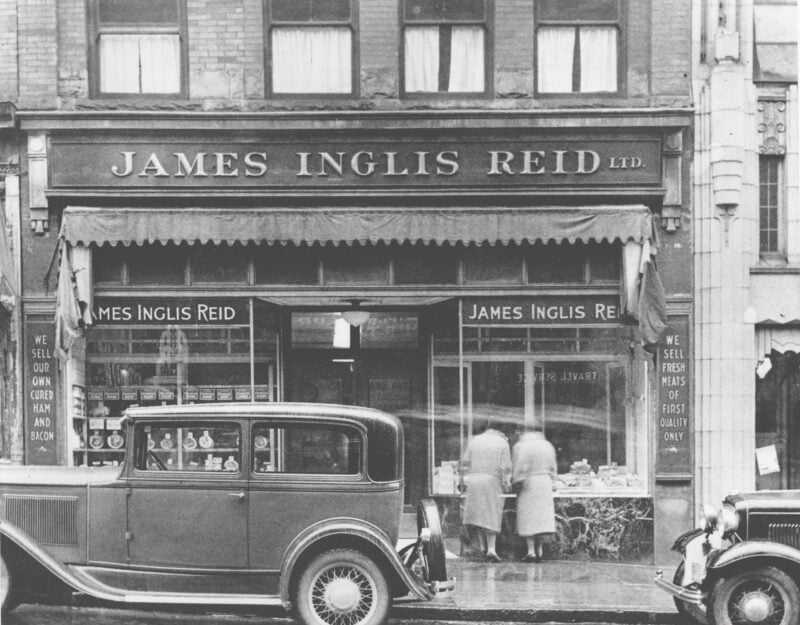
Some of the personal details illustrate how Reid’s Meats (its colloquial name) depended on family and close friends. Part of James Reid’s 1908 marriage agreement with Margaret Crombie, his Scottish sweetheart, included supporting her widowed mother, and sister. Reid brought them to Canada, and his sister-in-law Agnes Crombie (“Nessie”) worked in the business for many years. Margaret Crombie Reid made the haggis in a bowl until Nelson Horatio Menzies was brought to Canada in 1917 to take over the job and build a huge haggis following. Nephew Willie Reid was the master curer for over forty years, one of only three people who knew the secret curing recipe for Ayrshire and other types of ham and bacon.
Through promoting old-country traditional methods by skilled craftspersons, Reid capitalized on the desires of many Scots who had left their home country and wanted to keep their food traditions. At 559 Granville, the marble entryway doorstep read “Value Always” and customers might have felt they were stepping into a true Glaswegian shop. Homely signs such as “Our Own Cure” and “Perfection” were scattered throughout the store. The slogan on the store awning, “The Larder of the Wise”, implied quality products and discerning customers. When Reid advertised in the Scottish Directory, he added a line that Scots would appreciate; “Aye, and Haggis forbye,” a part of the insider approach that worked so well for his business.
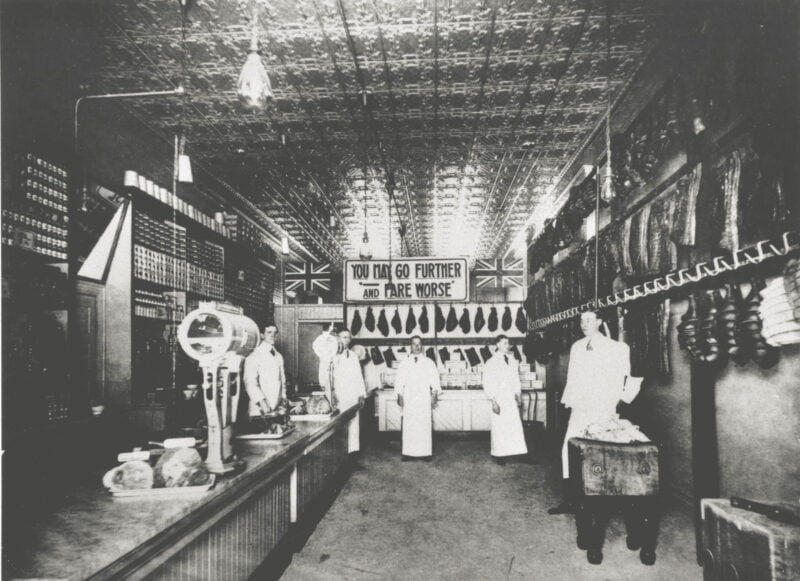
In 1929, James Reid had a house built for the family at 5950 North West Marine Drive, near University Hill. The company was incorporated in 1931 with two directors, Reid as president, and the accountant, Charles Alexander (Sandie) Glennie. Each held one ordinary share with the remaining 98 held by Reid. The aim, according to Wyness, was to have the employees buy Reid out in 10 years according to years of service.
Then, tragedy struck. Knox, the fifteen-year old son of James and Margaret Reid died in a sailing accident in 1935. In 1943 another loss occurred, of the financial sort. Sandie Glennie was dismissed for alleged embezzlement of funds. The book describes missing funds over a number of years and a serious deficit: Glennie had been almost second in command after James Reid. It must have been a nasty affair on all sides.
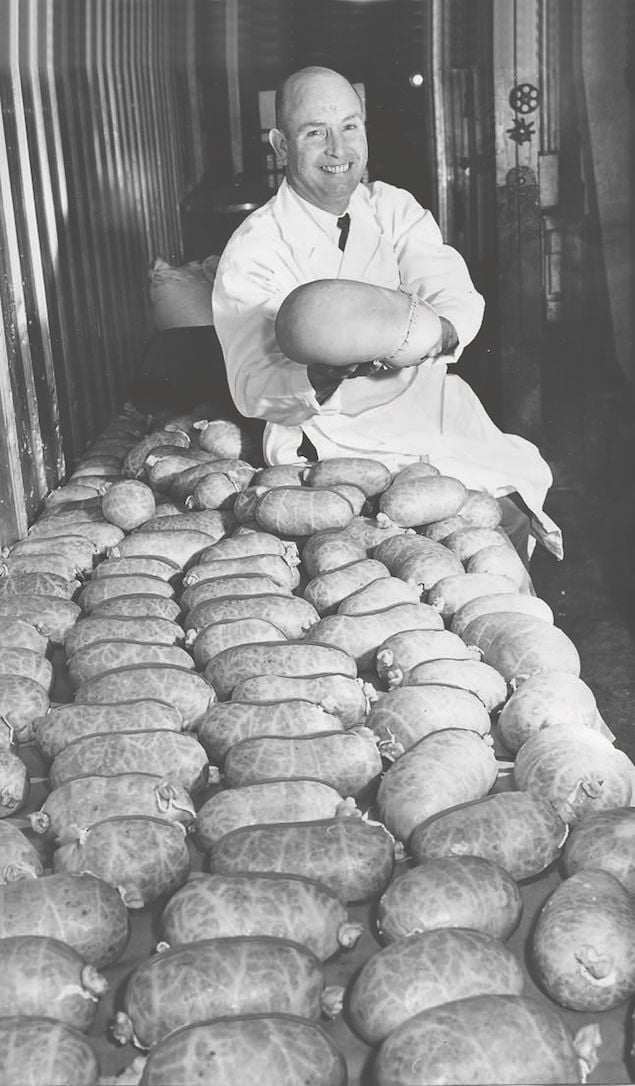
In 1945, Gordon Young Wyness, who had married Alison Reid, became the manager. With a degree in engineering, he had to learn quickly and spent some time learning different required skills outside his area of expertise. (A photograph in the book shows Gordon Wyness instructing Joan Seidl, curator of history at the Museum of Vancouver how to string a pretend ham used in the James Inglis Reid Ltd. display at the museum). To Wyness’s credit, he had some management previous experience in the meat industry.

Gordon Wyness maintained Scottish food traditions and expanded the customer base. He noted the affinity for haggis in the Chinese Canadian community well before Todd Wong instituted Gung Haggis Fat Coy in Vancouver.
Little changed at Reid’s Meats under Gordon Wyness’s management, although he was in charge of the store for 39 years, the same length of time as James Reid. When the Pacific Centre Mall wanted to expand in the 1980s, the demise of “The Larder of the Wise” was on the horizon. Anne Wyness relates how Cadillac Fairview arranged a tour of two Toronto malls for her to see the possibilities of re-creating a version of Reid’s Meats in the new mall. The move would require two separate locations to integrate retail and production elements; equipment was old and irreplaceable. The wooden curing barrels were sixty years old; strict adherence to traditions worked against the viability of the business. James Inglis Reid Limited closed in December 1986. It had survived the Great War, the Roaring Twenties, the Great Depression, World War II, post-war prosperity, and economic recessions but in the end, something as small as the lack of skilled coopers to make new curing barrels might have done the business in.
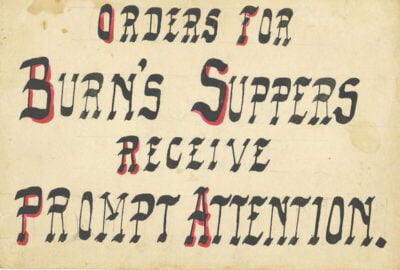
I read Anne Wyness’s account thoroughly, including the impeccable chapter endnotes. I enjoyed the haggis lore and wondered what was so secret about Reid’s curing recipe for ham and bacon that it had to be mixed behind a screen in the second-floor office. The book emphasizes the importance of integrity, character, business ethics, and traditions in maintaining Reid’s Meats. I started to look for more stories and suspense and began to speculate on omissions. A stronger story placing Reid’s Meats in the mainstream of Canadian society could have included discussions of the meatpacking business in Canada. Burns and Company and Swift Canadian are mentioned lightly — what about the roles of unions and non-unionized shops, labour unrest and strikes? What if the province of BC had wanted to keep a historic downtown? What if Expo ’86 had not set the course so firmly for Vancouver?
At Reid’s Meats, employees and family members were treated almost the same. Therefore, I wonder about the devastating death of Knox Reid in 1935, and the repercussions on later events, such as the sudden firing of Sandie Glennie in 1943 for alleged embezzlement [I say alleged because no charges were laid so far as I could determine, not to say that the theft did not happen]. It is hard to assume that Reid, a canny businessman, would not have noticed the firm was continually losing money. Was the family in deep grief? Had Glennie taken advantage of weakness? Was there jealousy among employees?
In the forty years between Gordon Wyness’s assumption of leadership and the closing of Reid’s Meats, the business changed very little. What effects did sticking to traditions have on the resilience of the business?
Writing about one’s family business is not easy. Writing memoir and biography is not easy either. Writing about one’s own family in business is probably the most difficult task of all. Tucked in with immense amounts of data, Wyness has provided us with several gems to remember about a top-quality Vancouver family-owned business with a few mysteries to explore further.
*

Mary Leah de Zwart is a co-founder of the BC Food History Network Blog (BCFHNB) which she and two other home economists from UBC, Linda Peterat and Gale Smith, started in 2013. BCFHNB was initially funded by grants from the History Education Network [THEN/Hier], the Canadian Home Economics Foundation, and Teachers of Home Economics Specialist Association. Run by volunteers, BCFHNB has focused on researching and increasing awareness of food history topics in BC and Canada, and has made over 100 blog posts on its website since 2016. Its most-viewed blog posts include “Japanese Mandarin Oranges,” by Gale Smith, “Buffaloberry: A Super Fruit,” by Mary Leah de Zwart, and “Canadian War Cake,” by Linda Peterat. Book reviews have been part of BCFHNB in addition to providing teacher resources and academic papers. Mary Leah de Zwart and the BCFHNB can be contacted at this email address: bcfoodhistory@gmail.com Editor’s note: Mary Leah de Zwart has also reviewed Lost Feast: Culinary Extinction and the Future of Food, by Lenore Newman, in The Ormsby Review.
*

The Ormsby Review. More Books. More Reviews. More Often.
Publisher and Editor: Richard Mackie
The Ormsby Review is a journal service for serious coverage of B.C. books and authors, hosted by Simon Fraser University. The Advisory Board consists of Jean Barman, Robin Fisher, Cole Harris, Wade Davis, Hugh Johnston, Patricia Roy, David Stouck, and Graeme Wynn. Scholarly Patron: SFU Graduate Liberal Studies. Honorary Patron: Yosef Wosk. Provincial Government Patron since September 2018: Creative BC
“Only connect.” – E.M. Forster


3 comments on “#949 Haggis and Scotch pies”
The history was great. However, what I need to know is where Haggis is now available to someone living in Vernon BC Canada? Cannot seem to find any I can obtain it.
Hi Allan, I will drop a line to Mary Leah and ask if she knows a Vernon source of haggis. As for me, I get mine at Windsor Quality Meats, 4110 Main St, Vancouver, on a seasonal basis. Maybe someone can send some up to you special delivery
 Good luck! Richard
Good luck! Richard
I have bought haggis at a specialty butcher shop in Edmonton, so I bet you could get some ordered in, frozen….It’s been 4 years since I lived in Vernon, so the shops might have changed..
This is a good meat shop in Edmonton, and I think you could phone or email The Butchery by Range Road.
12229 – 107 Ave | 780-443-0000 |
OPEN TUES – FRI 10AM – 5:30PM AND SAT 10AM – 4:30PM
Myself, I like neeps and tatties. Easier to cook. One website suggests steak pie as a substitute.
M.L. de Zwart visit BCFoodhistory